Processed Fish Market Research, 2031
The global processed fish market size was valued at $66.9 billion in 2021, and is projected to reach $87.2 billion by 2031, growing at a CAGR of 2.8% from 2022 to 2031.

The processed fish market is segmented into Fish Type, Product, Application, and Distribution Channel.
Processed fish is preserved by curing it by smoking, salting, fermenting, and adding any chemical to extend its shelf-life and improve its taste. Fishes, such as cod, mackerel, tilapia, catfish, salmon, Pollock, and tuna are commonly used to produce processed fish. Certain preservatives are added to the fish to protect it from spoiling due to bacteria and other such organisms.
The rapid expansion of fast-food chains and restaurant chains has had a significant influence in increasing consumption of processed fish. Moreover, the discounts and affordable meal packages offered by these restaurant chains significantly contribute to the growth of the processed fish market across the globe. According to the U.S. Center for Disease and Control Prevention, approximately 37% of the American population consumes fast food on daily basis. Therefore, the increased consumption of processed fish in developed regions has fostered the processed fish market growth.
The busy lifestyle of consumers owing to the rise in the number of employments has resulted in an increase in consumption of ready-to-cook and ready-to-eat food. The convenience and time-saving factors associated with ready-to-eat food have resulted in rising processed fish market demand. This is a significant element driving the growth of the global processed fish industry.
Growing urban population and rapid urbanization is a major factor propelling the growth of the market. The fast-food chains, cafes, and popular hotels are restricted to megacities and towns. These fast-food chains and cafes play a significant role in the sales of the processed fish. According to the United Nations, 60% of the global population is expected to be living in urban areas by 2030 growing from 55% in 2018. This provides a lucrative opportunity to the processed fish vendors to boost their revenues due to rise in the prospected customer base. According to United Nations, North America was the most urbanized region in 2018, with around 82% of its population residing in urban cities. North America was followed by Latin America and the Caribbean with 81% and Europe with 74%. Africa and Asia have the lowest level of urbanization with 43% and 50% of the population living in urban areas, respectively. Therefore, Africa and Asia-Pacific are expected to offer great growth opportunities in the upcoming future.
According to the International Standard Statistical Classification of Aquatic Animals and Plants, the seafood groups can be segmented into larger predator fish and smaller forage fish. Large predator fishes include sharks, tuna, marlin, swordfish, mackerel, and salmon, whereas smaller forage fishes are herring, sardines, sprats, anchovies, and menhaden. Thus, wide range of species leads to availability of a large number of processed fish options, and is thus projected to drive the growth of the processed fish market size.
However, the carcinogenic nature of the processed food may hamper the market growth. The World Health Organization has classified processed food as Group 1 carcinogenic, which means there are convincing evidences available that prove that consumption of processed fish can cause colorectal cancer. Therefore, consumption of more than 700 grams of processed fish in a week increases the risk of cancer. The rising consumer awareness, growing health consciousness, and growing demand for healthy food products are few factors that may stimulate the health-conscious population to avoid the consumption of processed fish. Therefore, the carcinogenic properties of processed food may hamper the growth of the global market during the forecast period.
The market is segmented on the basis of fish type, product, application, distribution channel, and region. By fish type, the market is categorized into capture and aquaculture. Both, the capture and aquaculture segments are specifically further bifurcated into cod, salmon, tuna, sardines, mackerel, and others. Moreover, depending on product, it is segmented into frozen, cured, and prepared and preserved segments. On the basis of application, the market is segmented into commercial and residential. Depending on distribution channel, the processed fish market is categorized into supermarkets and hypermarkets, convenience stores, independent retailers, online sales, and others. Region-wise, the market is analyzed across North America, Europe, Asia-Pacific, and LAMEA (Latin America, Middle East, and Africa).
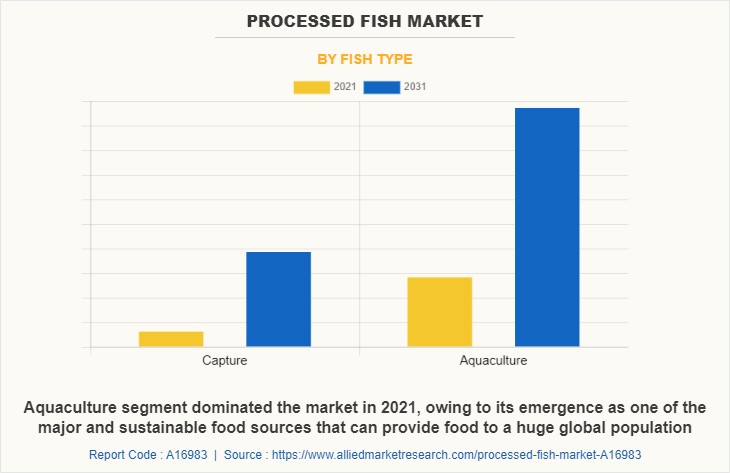
As per the processed fish market forecast, by fish type, the aquaculture is the largest and the fastest-growing segment. This segment accounted for 53.3% of the processed fish market share in 2021 and is expected to grow at a CAGR of 3.5% during the forecast period. With the increasing demand for food, lack of availability of agricultural land, climate change, and rapidly growing global population, the threat of scarcity or shortage of food sources from agriculture sector is increasing across the globe. Aquaculture is emerging as one of the major and sustainable food sources that can provide food to a huge number of population. The surge in penetration of major food processing companies and growing demand for convenience food and ready-to-cook and ready-to-eat food products among the consumers in the developed and developing economies are significantly fostering the growth of the market across the globe. The demand for packaged food is increasing among the working population owing to rising disposable income, changing consumption pattern, and busy and hectic life schedules. Therefore, the rising penetration of food processing companies in the developing nations, rising employment levels in the male and female population, and rise in penetration of modern trade and online groceries are some of the major factors that are expected to drive the growth of the aquaculture segment.
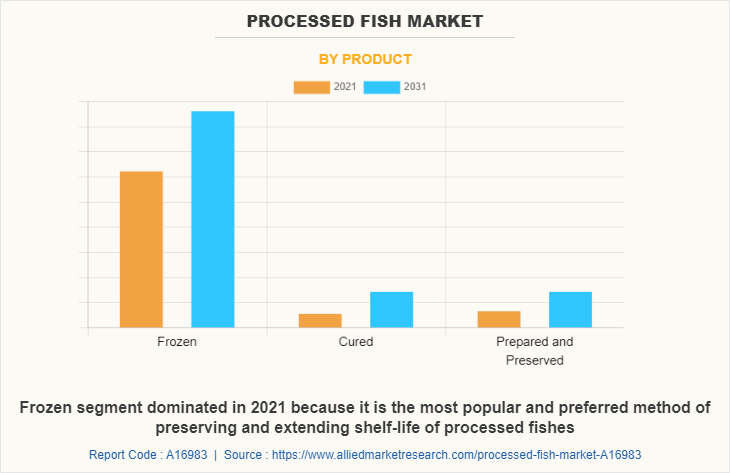
As per the processed fish market trends, on the basis of product, the frozen segment dominated the market, garnering the highest processed fish market share in 2021. This is attributed to factors, such as technological advancements pertaining to storage, increasing the shelf life of fish meat, growing preference for convenience and ready-to-cook foods, and growing demand from household and commercial sectors. The growing population of young professionals is boosting the demand for frozen processed fish. Moreover, the growing penetration of food service players, cloud kitchens, and online food delivery platforms is further propelling the growth of the frozen segment.
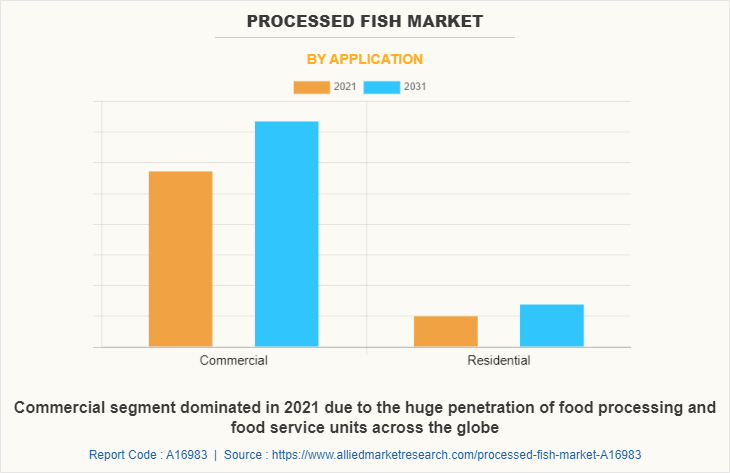
By application, the commercial segment dominated the market in 2021. The huge presence of food processors and food service units in developed economies like Europe and North America has led to the huge growth of the commercial segment in the market. The rising popularity of eating-out culture in developing nations is further expected to fuel the growth of the commercial segment in the forthcoming future. The growing penetration of supermarkets and hypermarkets, convenience stores, cloud kitchens, online grocery delivery platforms, and hotels and restaurants across different nations are some of the major factors that are anticipated to drive the growth of the market through the commercial sector in the forthcoming future. According to U.S. Department of Agriculture, spending on food away from homes (restaurant, full-service and fast food) accounted for $1.17 trillion or 55% of total food expenditures, in 2021.
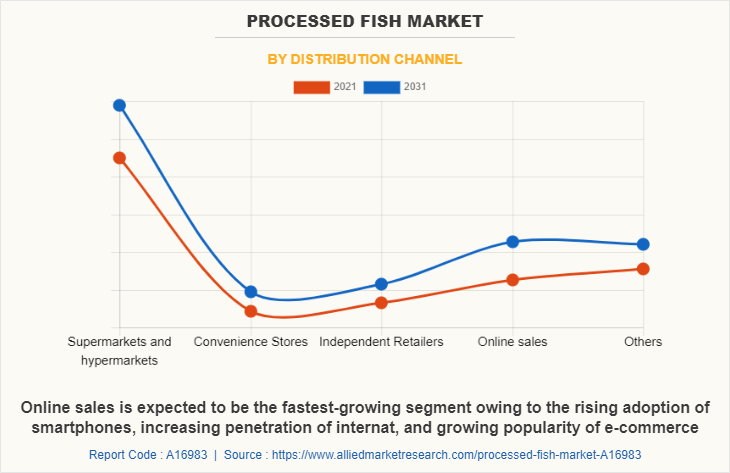
Depending on the distribution channel, the online sales channel is expected to be the fastest-growing segment during the forecast period. The online platform serves as a popular medium for the purchase of food ingredients and processed fish. This is attributed to easy availability and the benefits, such as information about the attributes of the products, time-saving features, and the facility of home delivery provided by the online platform. In addition, consumers prefer to buy products online since it is convenient and offers a large selection of brands that are not available in retail. Moreover, the online sales channel has increased consumer reach, owing to which, it has evolved as a key source of revenue for many companies. Consumers are becoming more aware of the many purchase patterns that exist in society as technology advances and internet services become more widely available. The technology attracts millennials and generation Z and is expected to influence the buying pattern of products. On the other hand, due to time constraints, customers may choose to buy adult incontinence products online. According to the United Nations Conference on Trade and Development (UNCTAD), the e-commerce sector's proportion of total retail sales increased from 16% to 19% in 2020. Furthermore, online sales are expected to grow notably shortly, due to the rapid increase in mobile users. Increase in e-commerce sales, improvements in logistics services, and ease in payment options further boost the growth of the market.
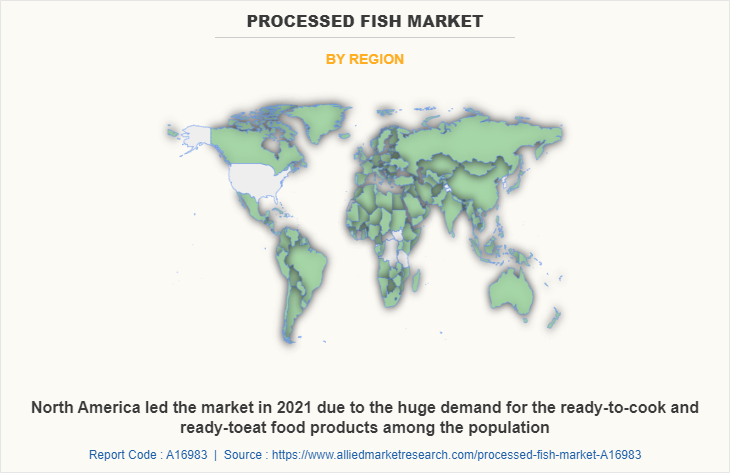
Region-wise, North America dominated the market in 2021. North America is the leading consumer of processed fish products such as canned, frozen, and chilled fishes. The increased consumer awareness regarding the health benefits of seafood, growing demand for organic fish products, huge presence of restaurants and cafes, increased penetration of packaged food and top food processing companies, and increased demand for the convenience food products are the prominent factors that are responsible for the significant growth of the North America in the global market.
Asia-Pacific processed fish market is expected to grow at a CAGR of 4.0% from 2022 to 2031. Asia-Pacific is an emerging region, and is the one of the largest consumers of seafood across the world. The growth of Asia-Pacific processed fish market is attributed to surge in disposable income, increase in trend of dining out, and rise in number of fast food restaurants that serve processed fish. The abundant availability of fishes in the region has significantly attracted the fish processing companies in the region. Moreover, the presence of huge population in the region presents a lucrative growth opportunity to the processed fish market players. The changing consumption pattern, rising penetration of HoReCa units, and rising popularity of dining out are the major factors expected to drive the growth of the Asia Pacific processed fish market.
Players operating in the processed fish market have used a variety of developmental strategies to expand their market share, exploit the processed fish market opportunities, and boost market profitability. The key players operating in the processed fish industry includes, Beach Cliff, Brunswick, Channel Fish Processing, Clover Leaf, Gadre Premium Seafood, Golden Prize Canning Co., Ltd., Goya Foods, Inc., MOWI, Oceans Secret, Perdue Farms, Safcol, Safe Catch, True North Seafood Company, Wild Planet Foods, and Young's Seafood.
Key Benefits For Stakeholders
- This report provides a quantitative analysis of the market segments, current trends, estimations, and dynamics of the processed fish market analysis from 2021 to 2031 to identify the prevailing processed fish market opportunities.
- The market research is offered along with information related to key drivers, restraints, and opportunities.
- Porter's five forces analysis highlights the potency of buyers and suppliers to enable stakeholders make profit-oriented business decisions and strengthen their supplier-buyer network.
- In-depth analysis of the processed fish market segmentation assists to determine the prevailing market opportunities.
- Major countries in each region are mapped according to their revenue contribution to the global market.
- Market player positioning facilitates benchmarking and provides a clear understanding of the present position of the market players.
- The report includes the analysis of the regional as well as global processed fish market trends, key players, market segments, application areas, and market growth strategies.
Processed Fish Market Report Highlights
| Aspects | Details |
| Market Size By 2031 | USD 87.2 billion |
| Growth Rate | CAGR of 2.8% |
| Forecast period | 2021 - 2031 |
| Report Pages | 300 |
| By Fish Type |
|
| By Product |
|
| By Application |
|
| By Distribution Channel |
|
| By Region |
|
| Key Market Players | Oceans Secret, true north seafood, Safe Catch, Safcol (The Seafood Experts Australia Pty Ltd.), perdue farms, wild planet foods, MOWI ASA, Brunswick Seafood, clover leaf seafoods, Goya Food Inc., channel fish processing (cfp), Golden Prize Canning Co., Ltd., Young's Seafood, Gadre Premium Seafood, Beach Cliff |
Analyst Review
The demand for processed fish is expected to rise in the upcoming future. The rising global population is expected to add pressure on the global food supply chain. With the shrinking cultivable lands, the aquaculture is expected to play the most vital role in supplying food. Asia-Pacific is the largest producer of fish and other seafood. Over 60% of the global population lives in Asia-Pacific and their higher dependence on seafood is attracting the major fish processing companies in the region. The developing nations like China, India, Vietnam, and Philippines in the Asia-Pacific region are expected to provide impetus to the demand for processed fish owing to the rising penetration of foodservice and food processing companies coupled with the changing consumption habits of the populous.
The CXOs further added that e-commerce will play an exceptional role in the growth and development of the processed fish market. The use of internet technology coupled with growing adoption of smartphones and growing e-commerce platforms is expected to positively and significantly boost the sale of the processed fish. The growing penetration of various food delivery platforms, such as Deliveroo, Grubhub, Dunzo, Faasos, Eatfit, Scootsy, and Zomato is boosting the sales of processed meat. Millennials tend to order food from these e-commerce platforms more frequently and hence, it is positively impacting the growth of the processed fish market across the globe.
The global processed fish market size was valued at $66,879.9 million in 2021, and is estimated to reach $87,172.2 million by 2031, registering a CAGR of 2.8% from 2022 to 2031. The rapid expansion of fast-food chains and restaurant chains has had a significant influence in increasing consumption of processed fish. Moreover, the discounts and affordable meal packages offered by these restaurant chains significantly contribute to the growth of the processed fish market across the globe.
The processed fish market report is available on request on the website of Allied Market Research.
The forecast period considered in the global processed fish market report is from 2022 to 2031. The report analyzes the market sizes from 2022 to 2031 along with the upcoming market trends and opportunities. The report also covers the key strategies adopted by the key players operating in the market.
The key players operating in the processed fish industry include, Beach Cliff, Brunswick, Channel Fish Processing, Clover Leaf, Gadre Premium Seafood, Golden Prize Canning Co., Ltd., Goya Foods, Inc., MOWI, Oceans Secret, Perdue Farms, Safcol, Safe Catch, True North Seafood Company, Wild Planet Foods, and Young's Seafood.
The processed fish market is segmented on the basis of fish type, product, application, distribution channel, and region. By fish type, the market is categorized into capture and aquaculture. Both, the capture and aquaculture segments are specifically further bifurcated into cod, salmon, tuna, sardines, mackerel, and others. Moreover, depending on product, it is segmented into frozen, cured, and prepared and preserved segments. On the basis of application, the market is segmented into commercial and residential. Depending on distribution channel, the processed fish market is categorized into supermarkets and hypermarkets, convenience stores, independent retailers, online sales, and others. Region-wise, the processed fish market is analyzed across North America, Europe, Asia-Pacific, and LAMEA (Latin America, Middle East, and Africa).
Asia-Pacific processed fish market is expected to grow at a CAGR of 4.0% from 2022 to 2031. Asia-Pacific is an emerging region, and is the one of the largest consumers of seafood across the world. The growth of Asia-Pacific processed fish market is attributed to surge in disposable income, increase in trend of dining out, and rise in number of fast-food restaurants that serve processed fish.
Region-wise, North America dominated the market in 2021. North America is the leading consumer of processed fish products such as canned, frozen, and chilled fishes. The increased consumer awareness regarding the health benefits of seafood, growing demand for organic fish products, huge presence of restaurants and cafes, increased penetration of packaged food and top food processing companies, and increased demand for the convenience food products are the prominent factors that are responsible for the significant growth of the North America in the global processed fish market.
COVID-19 negatively impacted the growth of the global processed fish market. The closure of international boundaries hampered the export and import of fish. Further, the lockdown resulted in decreased demand for processed fish in the food service industry.
Loading Table Of Content...


